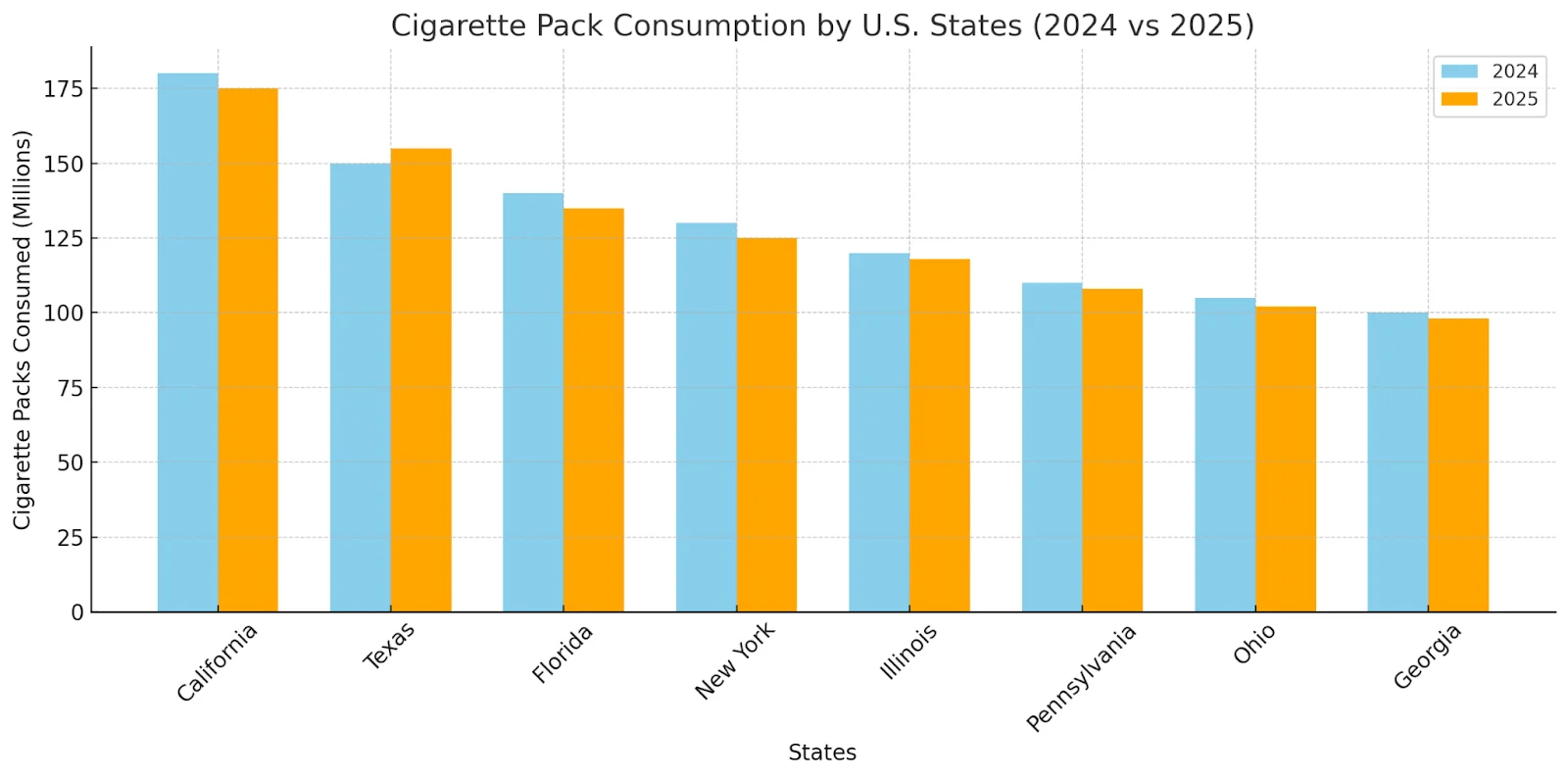Have you ever seen a small box of cigarettes? That small box is called a pack. Many of these small packs are assemble in one big box called a carton. If you're wondering, how many packs of cigarettes in a carton? you are not alone! Many people ask this question, especially those who work in stores, factories, or packaging companies.
In this blog, we will learn all about cigarette packs, cartons, and why packaging is very important in this business.
What Is a Cigarette Pack?
A cigarette pack is a small box that usually has 20 cigarettes inside. It is easy to carry and keeps the cigarettes safe. These packs are often made of paperboard or cardboard, which makes them strong but not heavy.
Each pack has:
- A printed brand name
- Health warning signs
- A flip-top or soft opening
These packs are made by packaging companies that print and cut the paper to make them look good and protect the cigarettes inside. Standard dimensions for a cigarette pack are approximately 3.5 inches in width, 2.25 inches in height, and 0.88 inches in depth. These dimensions are designed to ensure portability and ease of storage.
What is a Cigarette Carton?
A carton is a bigger box that holds many small packs. So, if you go to a store and see a large cigarette box behind the counter that is the carton.
So, how many packs of cigarettes in a carton?
The answer is usually 10 packs.
That means one carton has:
- 10 packs of cigarettes
- Each pack has 20 cigarettes
- So one carton has 200 cigarettes in total!
The standard dimensions of a cigarette carton are approximately 8.3 inches in length, 6.3 inches in width, and 2.2 inches in height . These dimensions facilitate efficient stacking and storage during transportation and display.
Cigarette Carton vs. Pack of Cigarettes
Understanding the differences between a cigarette pack and a carton is crucial for both consumers and retailers. Here's a comparative overview:
|
Feature |
Cigarette Pack |
Cigarette Carton |
|
Contents |
20 cigarettes |
10 packs (200 cigarettes) |
|
Dimensions |
3.5" x 2.25" x 0.88" |
8.3" x 6.3" x 2.2" |
|
Purpose |
Individual use |
Bulk purchase/sale |
|
Portability |
High |
Moderate |
|
Packaging Material |
Paperboard/Cardboad |
Corrugated Cardboard |
Variations in Cigarette Pack and Carton Sizes by Country
Cigarette packaging standards can vary significantly across different countries due to regulatory policies, taxation, and consumer preferences.
Two main aspects typically vary:
- Pack Size: The number of cigarettes in one pack (usually 20 or 25 cigarettes per pack).
- Carton Size: The number of packs in one carton (usually 8 or 10 packs of cigarette per carton).
Here's an overview of how pack and carton sizes differ globally:
Table Chart of Cigarette Pack and Carton Sizes by Country
|
Country |
Cigarettes per Pack |
Packs per Carton |
|
United States |
20 |
10 |
|
United Kingdom |
20 |
10 |
|
Australia |
25 |
10 |
|
Canada |
25 |
8 or 10 |
|
Japan |
20 |
10 |
|
Malaysia |
Minimum 20 |
10 |
These variations are influenced by local laws, health regulations, and market demands.
Packs of Cigarettes in Top USA Brands' Packaging
In the United States, cigarette packaging is standardized to a certain extent, especially when it comes to the number of cigarettes per pack and packs per carton. Most major brands follow this format:
- 1 Pack = 20 Cigarettes
- 1 Carton = 10 Packs
- 1 Carton = 200 Cigarettes
While the packaging format is mostly the same across top brands, here’s a table highlighting how popular U.S. cigarette brands package their products:
Cigarette Packaging Comparison: Top USA Brands
|
Brand |
Cigarettes per Pack |
Packs per Carton |
Total Cigarettes per Carton |
Special Packaging Options |
|
Marlboro |
20 |
10 |
200 |
Soft Pack, Box |
|
Newport |
20 |
10 |
200 |
Box |
|
Camel |
20 |
10 |
200 |
Box, Crush (menthol) |
|
American Spirit |
20 |
10 |
200 |
Organic, Perique Blend |
|
Pall Mall |
20 |
10 |
200 |
Longer Lengths Available |
|
Winston |
20 |
10 |
200 |
Box, 100s |
|
Parliament |
20 |
10 |
200 |
Recessed Filter Design |
|
Lucky Strike |
20 |
10 |
200 |
Original, Menthol |
|
Virginia Slims |
20 |
10 |
200 |
Ultra Slim Design |
Key Notes:
- Soft Pack vs. Hard Pack: Soft packs are more flexible but less protective; hard (box) packs are more rigid and popular.
- Carton Purchases: Most smokers buy by the pack, but cartons are economical for frequent users.
- Menthol Options: Brands like Newport and Camel Crush offer menthol in unique packaging formats.
- Length Variants: Pall Mall and Virginia Slims offer 100s and extra-long versions with the same pack count.
Yearly Comparison of Cigarette Pack Consumption in USA

The bar graph above presents estimated cigarette pack consumption (in millions) across selected U.S. states during a recent two-year period. The figures reflect how smoking habits vary by region due to factors like population size, lifestyle trends, taxation, and tobacco regulations.
Key Insights:
- California consistently shows the highest cigarette consumption, with a slight downward trend.
- Texas follows closely and shows a slight increase in usage.
- Florida and New York maintain stable consumption levels.
- States like Illinois, Ohio, and Pennsylvania reflect only minor changes, suggesting a steady rate of cigarette use.
Regulatory Trends and Health Warnings
1. Graphic Health Warnings on Cigarette Packaging
In March 2020, the U.S. Food and Drug Administration (FDA) finalized a rule requiring cigarette packages and advertisements to display 11 new health warnings. These warnings consist of textual statements accompanied by color graphics depicting the negative health consequences of smoking. The warnings are designed to cover 50% of the front and back panels of cigarette packages and 20% of the area at the top of advertisements. Legal challenges delayed enforcement, but as of May 2024, the rule is in effect.
2. Ban on Flavored Cigarettes
Under the Family Smoking Prevention and Tobacco Control Act, the FDA banned cigarettes with characterizing flavors (other than menthol and tobacco) to reduce youth smoking. This ban includes flavors such as strawberry, grape, orange, clove, cinnamon, pineapple, vanilla, coconut, licorice, cocoa, chocolate, cherry, and coffee.
3. Minimum Legal Sales Age Raised to 21
On December 20, 2019, federal law raised the minimum legal sales age for tobacco products from 18 to 21 years. This "Tobacco 21" law aims to prevent and delay the initiation of tobacco use among youth and young adults. Retailers are required to comply with this law, regardless of state or local laws.
4. Plain Packaging Initiatives
While the U.S. has not implemented plain packaging laws, the World Health Organization (WHO) recommends such measures to reduce the attractiveness of tobacco products. Plain packaging on tobacco prodcuts involves removing logos, colors, brand images, and promotional information, allowing only brand names and product names in a standardized font and color.
5. State-Level Tobacco Tax Increases
Many U.S. states have increased excise taxes on cigarettes to discourage smoking and generate revenue for public health programs. For example, as of July 1, 2024, Colorado increased its cigarette tax by 30 cents to $2.24 per pack, and Maryland increased its tax by $1.25 to $5.00 per pack.
Importance of Packaging in the Cigarette Industry
Packaging plays a pivotal role in the tobacco industry, serving multiple functions beyond merely containing the product.
Protection
Packaging safeguards cigarettes from physical damage, moisture, and contamination, ensuring product integrity until consumption.
Compliance
Regulatory bodies mandate specific packaging requirements, including health warnings, ingredient disclosures, and standardized designs to discourage smoking.
Branding
Despite restrictions, packaging remains a key branding tool, helping consumers identify products and fostering brand loyalty.
Marketing
Innovative flip top cigarette packaging designs can attract consumers, especially in markets where advertising is heavily regulated.
Convenience
Well-designed packaging enhances user experience, offering ease of access and portability
Customization and Eco-Friendly Packaging
With growing environmental concerns and the need for brand differentiation, many tobacco companies are exploring custom and eco-friendly packaging options.
Custom Packaging
Brands are investing in unique designs, materials, and finishes to stand out in the market. Customization can include embossing, foil stamping, and the use of distinctive colors and textures.
Eco-Friendly Materials
There's a shift towards using recyclable and biodegradable materials in empty cigarette packaging. Companies are adopting sustainable practices to reduce their environmental footprint and appeal to environmentally conscious consumers. These initiatives not only address environmental concerns but also cater to a market segment that values sustainability.
Final Thoughts
Understanding the structure and standards of cigarette packs and cartons is essential for consumers, retailers, and manufacturers alike. While the standard pack of cigarettes contains 20 cigarettes and a carton of cigarette comprises 10 packs of cigarettes (total 200 cigarettes in carton), variations exist globally due to regulatory and market differences. Packaging serves multiple purposes, from protecting the product to conveying health warnings and brand identity. As the industry evolves, there's a noticeable shift towards sustainable materials and standardized packaging to meet environmental concerns and public health objectives.
For businesses in the tobacco sector, staying informed about packaging regulations and consumer preferences is crucial. Partnering with a reliable packaging provider like HT Custom Boxes can help you meet regulatory standards, elevate your brand presentation, and embrace eco-friendly packaging solutions tailored to your needs.

 Aminah Zaheer
Aminah Zaheer















.webp)




















